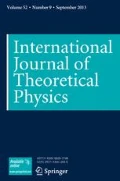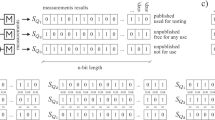Abstract
A quantum-proof extractor is a function that is used to extract randomness from any weakly random source X in the presence of prior quantum information about X. It is known that some constructions are quantum-proof, such as Trevisan’s construction. However, these extractors are generally restrictive for applications on the one-bit output construction and the weak design. Here, we give a modular framework to combine multi-bit output extractors (not only one-bit) with pseudorandom transform, and show that it is sound in the presence of quantum side information. Then combined with the theory of operator spaces, we improve previous theoretical proofs, and discuss the security of two-bit output extractor by giving a tighter bound for it.

Similar content being viewed by others
References
Calude, B.C.S.: Information and Randomness: An Algorithmic Perspective, 2nd edn, Revised and Extended. Siam Review (2010)
Binder, K.: Applications of monte carlo methods to statistical physics. Reports Progress Phys. 60(60), 487–559(73) (1997)
Ferrenberg, A.M., Landau, D.P., Wong, Y.J.: Monte carlo simulations: Hidden errors from “good” random number generators. Phys. Rev. Lett. 69(23), 3382–3384 (1992)
Shaltiel, R.: Recent developments in explicit constructions of extractors. Bull. Eur. Assoc. Theor. Comput. Sci. Eatcs 77(77), 67–95 (2002)
Lu, C.J., Reingold, O., Vadhan, S., et al.: Extractors: Optimal up to constant factors. Stoc, 602–611 (2003)
Trevisan, L., Vadhan, S.: Extracting randomness from samplable distributions. In: Annual Symposium on Foundations of Computer Science, pp. 32–42 (2000)
Mauerer, W., Portmann, C., Scholz, V.B.: A modular framework for randomness extraction based on Trevisan’s construction. Comput. Sci. (2012)
Bennett, C.H., Brassard, G., Robert, J.M.: Privacy amplification by public discussion. SIAM J. Comput. 17, 210–229 (1988)
Renner, R.: Security of quantum key distribution. Int. J. Quantum Inf. 6(1), 1–127 (2005)
Tomamichel, M., Schaffner, C., Smith, A., Renner, R.: Leftover hashing against quantum side information. IEEE Trans. Inf. Theory 57(8), 2703–2707 (2010)
Barak, B., Shaltiel, R., Tromer, E.: True random number generators secure in a changing environment. Lecture Notes Comput. Sci. 2779, 166–180 (1970)
Trevisan, L.: Extractors and pseudorandom generators. J. Acm. 48(4), 860–879 (1999)
Hayashi, M., Tsurumaru, T.: More efficient privacy amplification with lessrandom seeds via dual universal hash function (2015)
Ma, X., Xu, F., Xu, H., et al.: Postprocessing for quantum random number generators: Entropy evaluation and randomness extraction. Phys. Rev. A 87 (6), 944–948 (2012)
Mo, L.I., Zhang, C.M., Yin, Z.Q., et al: An overview on the post-processing procedure in quantum key distribution. J. Cryptol. Res. (2015)
Vazirani, U., Vidick, T.: Certifiable quantum dice. R. Soc. London Philosop. Trans. 370(1971), 3432–3448 (2012)
König, R.T., Terhal, B.M.: The bounded-storage model in the presence of a quantum adversary. IEEE Trans. Inf. Theory 54(2), 749–762 (2006)
De, A., Portmann, C., Vidick, T., et al.: Trevisan’s extractor in the presence of quantum side information. Siam J. Comput. 41(4) (2009)
Ta-Shma, A., Zuckerman, D., Safra, S.: Extractors from reedmuller codes. J. Comput. Syst. Sci. 72, 786–812 (2006)
Shaltiel, R., Umans, C.: Simple extractors for all min-entropies and a new pseudorandom generator. J. Acm 52(2), 172–216 (2005)
Gavinsky, D., Kempe, J., Wolf, R.D.: Exponential separation of quantum and classical one-way communication complexity for a boolean function. Electron Colloquium Comput Complex (2006)
Berta, M., Fawzi, O., Scholz, V.B.: Quantum-proof randomness extractors via operator space theory. Physics (2015)
König, R., Renner, R., Schaffner, C.: The operational meaning of min- and max-entropy. IEEE Trans. Inf. Theory 55(9), 4337–4347 (2009)
Nisan, N., Zuckerman, D.: Randomness is linear in space. J. Comput. Syst. Sci. 52(1), 43–52 (1996)
König, R, Renner, R.: Sampling of min-entropy relative to quantum knowledge. IEEE Trans. Inf. Theory 57(7), 4760–4787 (2007)
De, A., Vidick T.: Near-optimal extractors against quantum storage. In: Proceedings of the Annual Acm Symposium on Theory of Computing, pp. 161–170 (2010)
Acknowledgments
This work is funded by the China Postdoctoral Science Foundation (Grants No. 2014M562582).
Author information
Authors and Affiliations
Corresponding author
Rights and permissions
About this article
Cite this article
Liu, Y., Guo, J. & Cui, J. A Modular Framework for Quantum-Proof Randomness Extractors. Int J Theor Phys 55, 5157–5171 (2016). https://doi.org/10.1007/s10773-016-3137-1
Received:
Accepted:
Published:
Issue Date:
DOI: https://doi.org/10.1007/s10773-016-3137-1




